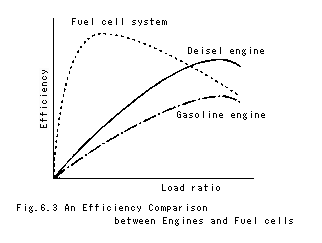|
Hybrid Electric Vehicles (HEV)
The hybrid electric vehicle in which an electric motor and battery are combined with a gasoline-powered engine has become a focus of attention because its driving range to overcome one of the drawbacks of the electric vehicles.
The hybrid system is generally considered to be more promising than the electric vehicles, for a wide range of models from passenger cars to trucks and buses.
The hybrids consist of three configuration types of an engine and motor:
- Series typeFThe engine is used only for electric power generation.
- Parallel typeFThe engine and motor have separate roles in driving the vehicle respectively.
- Dual typeFThis type combines the strong features of the above two types.

The hybrid electric vehicle will achieve a considerable fuel economy improvement in all ranges of driving. The reason is that, in the hybrid system, the engine is used to drive the vehicle during heavy-load conditions when the engine efficiency is high(as shown in Fig 6.3), while the motor drives the vehicle during light-load conditions when the engine efficiency is poor.
In the series type, exhaust emissions can be easily addressed due to the limited engine usage conditions; however, the vehicle driving performance is restricted by the motor power.
On the other hand, the parallel type can improve the output performance. However, it will become more difficult to take measures for reducing the amount of emission compared to the series type due to increased operation range of engine. The dual type can take advantage of the strong features but the system will become more complex. None of these three types require the battery to have such a large energy storage capacity as that for the electric vehicles. Instead, a higher power characteristics is required in relation to the charging and discharging of the battery.
In 1997, in the Japanese market, Toyota introduced the worldfs first mass-produced gasoline-electric hybrid vehicle equipped with a dual type system under the name of gPriush. This vehicle achieved a low fuel consumption of 29km /L. Toyota sold cumulatively about 50,000 Prius units as of November 2000. Following Toyota, Honda commercially released, in the autumn of 1999, its hybrid vehicle gInsiteh with light vehicle weight thanks to the aluminum body shell, which realized a low fuel consumption of 32 to 35 km/L. In the spring of 2000, Nissan started the sale of its hybrid vehicle gTino Hybridh with the dual type. Each of these three models is equipped with a regenerating system and has achieved the optimum fuel consumption, especially on city congested roads vehicles are more frequently accelerated or decelerated. However, the total vehicle costs are high in all the three models because of extra costs from additional devices such as the power system including the motor, battery, and control systems. In addition, optimization of the system controls is required for further lowering fuel consumption. More cost reduction efforts are necessary to decrease the amount greater than increased the amount of purchasing costs as mentioned above. Then these hybrid vehicles will be widely accepted by customers.


Reference
Book title: EV Handbook
Written by: EV Handbook Publisher's Group
Published by: Maruzen Co., Ltd. (URL http://www.maruzen.co.jp)
|